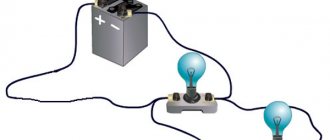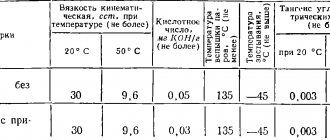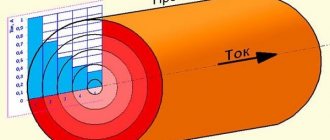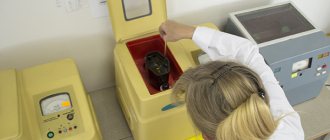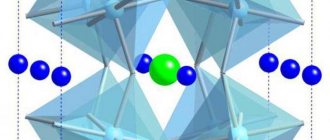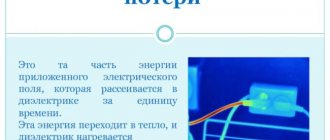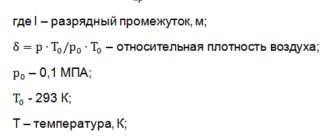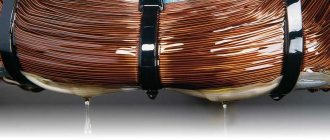Laboratory work No. 2
Liquid dielectrics
Completed Art. groups: EPb-151
Emelyanov Sergey Vladimirovich
Malakhova Tatyana Fedorovna
Purpose of work: Familiarization with liquid dielectrics and their application.
Liquid dielectrics
Dielectric is a substance (material) that conducts electric current relatively poorly. Liquid dielectrics are molecular liquids whose electrical resistivity exceeds 10 10 Ohm cm. Liquid dielectrics are electrical insulating liquids used in high-voltage electrical devices, as well as in electronic equipment units.
General characteristics of liquid dielectrics.
Liquid dielectrics are saturated aromatic, chlorinated and fluorinated hydrocarbons, unsaturated paraffin and vaseline oils, organosilicon compounds (polyorganosiloxanes), liquefied gases, distilled water, melts of some chalcogenides, etc. Liquid dielectrics are characterized by covalent bonding of electrons in molecules, and vans act between molecules -der-Waals forces.
The conductivity of liquids is determined by the ionization of molecules and the presence of impurities in the liquid. The main impurities that reduce electrical strength are microparticles, microbubbles and water. Purification of dielectric liquids (by distillation, partial crystallization, adsorption, ion exchange) leads to a decrease in electrical conductivity and dielectric losses and an increase in electrical strength. Electrical strength is largely a technological characteristic of the liquid dielectric and electrodes, methods of preparation and operation of the insulating gap. It is affected not only by those impurities that determine electrical conductivity, but also by the shape and material of the electrodes, pulse duration, and the presence of bubbles.
The most common liquid dielectrics used as electrical insulating materials are:
petroleum oils - transformer, capacitor and cable;
synthetic liquid dielectrics - polychlorinated biphenyl (Sovol, Sovtol), organosilicon and organofluorine;
Vegetable technical oils (castor, linseed, hemp and tung) are used to a limited extent in electrical insulating technology.
Properties of the most commonly used liquid dielectrics
Vegetable oils
Vegetable oils include castor, tung, linseed, and hemp. Vegetable oils are weakly polar dielectrics. Castor oil has high heat resistance and is used as a plasticizer and for impregnating paper capacitors. Tung, linseed, and hemp oils are “drying” oils. Drying is not caused by evaporation of the liquid, but by a chemical process based on oxidative polymerization. They are used as film-forming agents in varnishes (including electrical insulating ones), enamels and paints.
Castor oil is obtained from castor bean seeds; sometimes used to impregnate paper capacitors. The density of castor oil is 0.95-0.97 mg/m3, the pour point is from minus 10 to minus 180 ° C; dielectric constant Ɛ is 4.0 – 4.5 at a temperature of 200 °C; Epr=15-20 Mv/m. Castor oil does not dissolve in gasoline, but does dissolve in ethyl alcohol.
Flaxseed oil is golden yellow in color and is obtained from flax seeds. Its density is 0.93-0.94 Mg/m3, pour point is about -200 °C.
Tung (wood) oil is obtained from the seeds of the tung tree, which is grown in the Far East and the Caucasus. Tung oil is not edible and is even toxic. The density of tung oil is 94 mg/m 3, the pour point is from 0 to minus 50 ° C. Compared to linseed oil, tung oil dries faster. Even in a thick layer, it dries more evenly and gives a waterproof film than linen.
Digital library
General engineering disciplines / Materials science, technology of structural materials / 9.5 Liquid dielectrics
Liquid dielectrics have a number of advantages compared to gaseous ones: they have more than three times higher electrical strength, three times higher heat capacity, and 30 times higher thermal conductivity. The electrical properties of liquid dielectrics largely depend on the degree of their purification. Even a small content of ionic impurity significantly worsens their electrical characteristics. Particularly significant for electrical strength Epr
Liquid dielectrics are affected by undissolved polar impurities, such as water.
The main purpose of liquid dielectrics is to increase the electrical strength of solid porous insulation, remove heat from transformer windings, and extinguish electric arcs in oil switches. In capacitors, liquid dielectrics, impregnating solid insulation, increase its Epr
and dielectric constant (
ε
) and, thereby, the capacitance of the capacitor.
The most common liquid dielectrics are:
· petroleum oils – transformer, capacitor and cable;
· synthetic liquids – polychlorinated biphenyl (Sovol, Sovtol), organosilicon and organofluorine.
Vegetable technical oils - castor, linseed, hemp and tung - are currently used to a limited extent in electrical insulating technology.
Transformer oil (petroleum mineral oil, a mixture of various hydrocarbons) is used to fill power transformers. Here transformer oil plays two roles:
1) increases the electrical strength of insulation by filling the pores (of fibrous insulation) and the gaps between wires, windings, and transformer tank;
2) improves heat dissipation, since heat is generated when the transformer operates.
When filling high-voltage oil switches, transformer oil promotes faster cooling and extinguishing the electric arc formed when the contacts break. It is also used for filling oil-filled bushings, rheostats and other electrical devices. The electrical strength of transformer oil is 20…50 MV/m.
To impregnate paper capacitors, especially power capacitors, capacitor oil is used, which increases the dielectric constant of the paper dielectric and its electrical strength, which makes it possible to reduce the size, weight and cost of the capacitor.
Condenser oil can be petroleum or vaseline and has high purity. The latter has a higher pour point (-5°C). Electric strength of capacitor oils is not less than 20 MV/m,
Cable oils (petroleum) are used in the production of power electrical cables to impregnate paper insulation in order to increase its electrical strength and heat dissipation.
The disadvantage of petroleum oils is their fire hazard. In cases where complete fire and explosion safety is required, oil-filled transformers and capacitors cannot be used. In these cases, synthetic liquid dielectrics are used, for example, chlorinated hydrocarbons, silicon and organofluorine liquids, etc. Polar products of biphenyl chlorination are most widely used. They have a higher dielectric constant than petroleum oils, which makes it possible to reduce the size of capacitors. The disadvantage of chlorinated biphenyls is their high toxicity.
Organosilicon liquids
have low losses, low hygroscopicity and increased heat resistance. There are polymethyl (PMS), polyethyl (PES), phenylsiloxane (PPS) and other organosilicon liquids. Their main disadvantage is their high cost.
Organofluorine liquids (including liquid petroleum carbons) have excellent electrophysical characteristics. They have a low loss tangent, negligible hygroscopicity, high heat resistance and are capable of providing significantly more intense heat removal from cooled windings and magnetic circuits than petroleum oils or silicone liquids. An important advantage of organofluorine liquids compared to organosilicon liquids is complete non-flammability and high arc resistance. Their disadvantages are the high volatility of vapors, which requires sealing of devices into which organofluorine liquids are poured, as well as high cost.
LIQUID DIELECTRICS
Liquid dielectrics are low-molecular substances of organic origin, which can be polar or non-polar. Their electrical properties largely depend on the structure of the molecules and the presence of impurities. Impurities are formed during the oxidation and decomposition of hydrocarbon fractions, during the absorption of water and the ingress of particles of fibrous materials.
Liquid dielectrics are characterized by dielectric constant ε, electrical conductivity, dielectric losses (dielectric loss tangent tgδ), electrical strength E.
For polar liquids (Sovol, hexol, ethylene glycol), the dielectric constant ε is determined simultaneously by electronic and dipole polarizations. For example, for hexol ε = 3, for ethylene glycol ε = 40.
In non-polar liquids, the dielectric constant is determined mainly only by electronic polarization, does not depend on frequency and decreases with increasing temperature, approaching unity.
This phenomenon is explained by a decrease in the number of molecules per unit volume. Non-polar liquids have ε less than polar liquids. For example, for carbon tetrachloride ε = 2.163, for toluene ε = 2.294.
The electrical conductivity of liquid dielectrics is due to the movement of ions that arise as a result of the dissociation of the liquid itself and impurities, as well as the movement of charged impurity particles - molions. With increasing temperature, the mobility of ions and the degree of thermal dissociation increase. These factors increase electrical conductivity.
At low electric field strengths, Ohm's law comes into force, i.e. electric current I
, passing through the liquid, changes proportionally to the field strength.
In electric fields with high intensity E
(approximately 10...100 MV/m), the electric current does not obey Ohm's law due to the increase in the number of ions under the influence of the field.
In addition to ionic electrical conductivity, liquid dielectrics exhibit molion electrical conductivity, when charge carriers are tiny impurities. Such impurities can be water, various solid highly dispersed particles in suspension (fibers, dust particles, etc.). These particles adsorb ions on their surface and, when exposed to an electric field, move to the corresponding electrodes. In technical liquid dielectrics containing a certain proportion of impurities, molar conductivity predominates at room temperature. Molion conductivity is observed, for example, in transformer oil containing tiny particles of clay and emulsified water.
Purification of liquid dielectrics from impurities significantly increases their resistivity, but it is impossible to completely remove impurities.
The predominance of a particular type of conductivity depends on the dissociation energy, i.e., the energy required to destroy molecules and form ions. The higher the dissociation energy, the lower the ionic conductivity.
In polar liquids, dielectric losses consist of losses due to electrical conductivity and losses associated with dipole-relaxation polarization. They depend on temperature, frequency and viscosity of the liquid, since the rotation of dipoles in a viscous medium causes energy loss due to molecular friction. At high frequencies, liquid dielectrics have increased dielectric losses. For example, sovol at a temperature T-90°C and a frequency f
= 50 Hz has tanδ = 0.015. Therefore, liquid polar dielectrics are not recommended for use at high frequencies.
Dielectric losses in non-polar liquids that do not contain impurities are essentially losses due to electrical conductivity. They do not depend on frequency and increase with increasing temperature, which is explained by an increase in through current. The dielectric losses of these liquids are small, since their electrical conductivity is low. For example, pure transformer oil at temperature T = 90°C and frequency f = 50 Hz has tgδ = 0.003.
The electrical strength of liquid dielectrics is mainly determined by the presence of foreign impurities, liquid polarity, temperature and other factors. Gas bubbles present in the liquid are ionized, releasing energy that leads to local overheating of the liquid. This leads to the formation of a gas channel between the electrodes and, as a result, to breakdown of the liquid. In addition to gas inclusions, water is a significant factor that reduces the electrical strength of liquid dielectrics. Water droplets are polarized under the influence of an electric field and form chains with increased conductivity between the electrodes, along which electrical breakdown occurs. The electrical strength of liquids containing impurities is lower than that of purified ones.
Petroleum (mineral) oils (transformer, cable, capacitor), synthetic liquid dielectrics (chlorinated hydrocarbons, silicon and organofluorine liquids, esters of various types) and vegetable oils are used as liquid electrical insulating materials in electrical devices.
Petroleum electrical insulating
oils Petroleum oils are obtained through the process of stepwise distillation of oil and the removal of unstable compounds (naphthenic acids, sulfur, tar, oxygen, nitrogen, etc.) from the petroleum distillate (distillation product; for example, when distilling oil, distillates - gasoline, kerosene, lubricating oils, etc.) .
The technological operation of purifying petroleum distillate from foreign impurities is called refining. The performance properties of the oil depend to a certain extent on the quality of its implementation.
These oils have a number of properties that have made them widely used. They are relatively cheap and can be produced in large quantities, with good cleaning, they have a small dielectric loss tangent tgδ, and have a fairly high electrical strength.
The disadvantages of petroleum oils include a limited range of operating temperatures, fire and explosion hazards, and a tendency to aging.
When operating in a low-flow electrical apparatus, due to the oxidation of the corresponding fractions of hydrocarbons, the oil gradually ages, becoming darker. It produces partially soluble and insoluble polluting products. Insoluble heavy impurities settle on parts immersed in oil in the form of “sludge”, the viscosity of the oil increases, which impairs heat removal from heating parts. The aging process is accelerated by contact with air, especially if the air contains ozone; exposure to light and electric field; contact with certain metals (copper, iron, lead, etc.) and other substances with a crystalline structure; increased temperature, contact with rubber.
When aging in an electric field, some types of oils emit gases, which is dangerous, since gas bubbles can become sources of partial discharges. If the temperature of gaseous products (a mixture of oil vapor and air) exceeds their flash point, an explosion may occur.
The ability of oils not to emit gases when aging in an electric field (or even to absorb previously released gases) is called the gas resistance of oils.
To combat the aging of oils, the following means are used:
introduce antioxidant additives (substance inhibitors that slow down chemical reactions or stop them; used to slow down or prevent certain processes, such as metal corrosion, fuel oxidation (from the Latin inhibere - restrain, stop)), which easily combine with oxygen, protecting hydrocarbon fractions from oxidation, slow down the aging of oils and increase its service life; inhibitors are ionol, pyramidon, etc.;
limit the operating temperature (95°C for air-cooled transformers and 85°C for water-cooled transformers);
carry out continuous filtration of oils through adsorbents;
subject the aged oil to regeneration (Conversion of waste products into original ones for their reuse (from the Latin regeneratio - restoration, revival, renewal)), i.e. restoring its properties by cleaning and drying.
Transformer oil
- liquid from almost colorless to dark yellow. In terms of chemical composition, it is a mixture of naphthenic and paraffin hydrocarbons and therefore is a non-polar dielectric with low dielectric constant (ε = 2.2...2.3). After refining, the oil is further purified. To do this, it is treated with alkali, washed with water and dried. Final cleaning is carried out using adsorbents (Bodies on the surface of which a substance is absorbed from a solution or gas) (silica gel, infusorial earths) and filter presses.
Transformer oil has the following properties: low viscosity, which is very important, since too viscous oil removes heat loss from the windings and core of the transformer worse and impregnates porous insulation worse; pour point -70°C (which is especially important for equipment operating at low ambient temperatures);
electrical strength E
pr - 10...25 MV/m (very sensitive to moisture, but recovers upon drying);
The heat capacity and thermal conductivity of the oil increase with increasing temperature (with free convection (Transfer of heat, mass, charges by a moving medium, for example, air flows that arise naturally in a heterogeneous environment (natural convection) or created artificially (forced convection) (from the Latin convectio - import , carrying)) oil removes heat from the windings and transformer core immersed in it 25...30 times more intensely than air).
The main disadvantages of transformer oil are aging, flammability and combustibility, hygroscopicity (it is strictly forbidden to store it in open containers).
Transformer oil is used as an insulating and cooling medium in power and pulse transformers, reactors, high-voltage circuit breakers, such as arc extinguishing medium.
Cable oil
differs from transformer in increased viscosity, and from capacitor in reduced electrical properties. It is used as a component in oil-rosin compounds for impregnating the insulation of power cables.
Capacitor oil
obtained from transformer material after additional processing in a vacuum to remove dissolved air from it, which reduces dielectric losses. It is used to impregnate the insulation in paper and film capacitors, which makes it possible to reduce the overall dimensions, weight and cost of capacitors.
Synthetic liquid dielectrics. The use of synthetic liquid dielectrics is preferable in cases where their properties are superior to electrical insulating oils. For example, spruce requires the use of non-polar liquid dielectrics or liquid dielectrics with a higher fire and explosion hazard than electrical insulating oils.
Chlorinated hydrocarbons are produced by replacing some or even all of the hydrogen atoms with chlorine atoms in various hydrocarbons. The polar products of biphenyl chlorination are most often used. Chlorinated biphenyls, as well as the gases that are formed when these liquids are exposed to an electric arc, are toxic. Therefore, in a number of countries the use of chlorinated biphenyls for impregnation of capacitors is prohibited by law. The most famous representatives of this group are Sovol and Seutol-10. The atoms in the molecules of these materials are arranged asymmetrically, so Sovol and Seutol-10 are polar.
Sovol and sevtol-10 are slightly susceptible to aging, do not form explosive mixtures with air, are non-hygroscopic, toxic, and expensive.
Sovol (pentachlorobiphenyl) is a colorless viscous liquid obtained by chlorinating biphenyl (C12H10), as a result of which five hydrogen atoms of the latter are replaced by chlorine. Sovol is a non-flammable substance and does not oxidize, which is its main advantage over petroleum oils. However, its use is limited by the following disadvantages: density D
= 1500… 1560, flash point Tvsp = 205…230°C, pour point T3 = + 5°C, dielectric strength at temperature T= 20°C
E
pr = 14… 18 MV/m, significant viscosity and operating temperature ranges, which does not allow it to be used in its pure form; it is about 10 times more expensive than transformer oil.
It is used instead of capacitor oil for impregnation of low-voltage paper capacitors with increased capacity.
Sevtol-10 is a non-flammable liquid with a high pour point, which is obtained by diluting Sovol with trichlorobenzene. Used instead of transformer oil for explosive transformers.
Organosilicon liquids are a product of the synthesis of siliceous and carbon compounds, the properties of which are determined by the type of organic radicals. In accordance with this, polydimethylsiloxane, polydiethylsiloxane and polymethylphenylsiloxane liquids are distinguished.
These liquids are characterized by high heat resistance, low pour point, low temperature coefficient of viscosity, chemical inertness, low dielectric losses (dielectric loss tangent tgδ) and low hygroscopicity.
Polymethylsiloxane liquids are obtained by hydrolysis of dimethylchlorosilanes with trimethylchlorosilanes. They do not dissolve in alcohols and acetone, are highly inert and do not affect the properties of metals and rubbers upon contact with them. Used for impregnation of paper capacitors and hydrophobization of insulating tapes.
Polydiethylsiloxane liquids are mixtures of polyethylsiloxanes. Colorless. They are used for impregnation and filling of capacitors operating in the temperature range from -60 to 100°C.
Polymethylphenylsiloxane liquids are characterized by higher heat resistance and resistance to radiation.
The main properties of some electrical insulating liquids are given in Table 1.
Table 1. Basic properties of electrical insulating liquids
| Parameter | Sovol | Octol | Mineral oil | |
| transformer | capacitor | |||
| Density D, g/cm3 | 1,50… 1,56 | 0,85 | 0,84… 0,89 | 0,85. ..0,92 |
| Electrical resistivity p, Ohm-m | 1014… 10-15 | 1013.. 10-14 | 1014…1015 | 1014… 1016 |
| Dielectric constant ε at T = 20 °C | 5,0… 5,2 | 2,2… 2,4 | 2,1. ..2,4 | 2,1. ..2,3 |
| Dielectric loss tangent tgδ at | 0,002… | 0,005 | 0,0006… | 0,0003… 0,0006 |
| temperature 20 °C and frequency 50 Hz | …0,0004 | …0,001 | ||
| Electrical strength E at 20 °C | ||||
| frequency 50 Hz, kV/mm | 14.. .18 | 12.. .15 | 15.. .20 | 20… 25 |
| Temperature, °C: | ||||
| | hardening, no more | -8 | -15 | -45 | -45 |
| flashes, no less | 200… 230 | |||
| Acid number, mg KOH/g oil | 0,01. ..0,02 | 0,03 | 0,03… 0,05 | 0,015. ..1,020 |
Organofluorine liquids
are derivatives of hydrocarbons in which the hydrogen atoms are replaced by fluorine. Their vapors do not form explosive mixtures with air. They have low dielectric losses (dielectric loss tangent tgδ), negligible hygroscopicity, high heat resistance (some liquids can operate for a long time at temperatures of 200 °C and above), high thermal conductivity, complete non-flammability, and high arc resistance.
Organofluorine liquids are used for impregnation and filling of capacitors and transformers, for testing radio electronics elements at low and high temperatures.
In addition to the indicated liquid dielectrics, highly polar synthetic electrical insulating liquids are used in radio electronics. For example, ethylene glycol (HO - CH2 - CH2 - OH), which is used as a control liquid when monitoring the tightness of microcircuits.
Equipment and accessories: refractometer, set of flasks with solutions, glass rod, filter paper.

